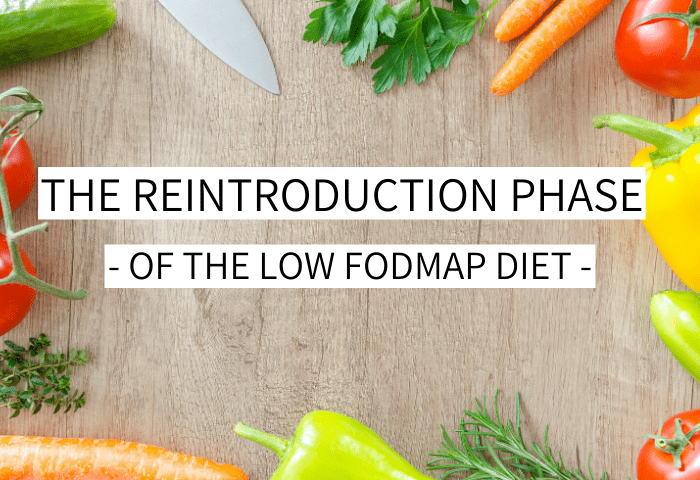
The FODMAP reintroduction phase
If you are reading this blog, that probably means you have successfully finished the elimination phase of the low FODMAP diet. Congratulations!
Now we are ready to move on to a nicer part of the low FODMAP diet: the FODMAP reintroduction!
A lot of people are a bit afraid of the reintroduction phase because they are scared that they will experience a lot of symptoms again.
And I fully understand that. But let’s try to look at it from the positive side: this phase is going to help you identify your food triggers and give you more of your freedom back around food. Isn’t that great?
In this article, I will give you all the information you need about the reintroduction phase, so you can do the tests successfully and find out your triggers.
What is the reintroduction phase?
The reintroduction phase is the second phase of the low FODMAP diet, also known as the challenge phase. The goal of this phase is to find out which FODMAP groups trigger your IBS symptoms.
You do this by testing/challenging the different FODMAP groups through food tests.
As I have explained in this blog about the low FODMAP diet, there are 6 FODMAP groups: fructose, lactose, sorbitol, mannitol, fructans, and galactans (GOS). In each test, you test one of these groups.
Each test consists of 3 testing days and on every testing day you test a larger amount of a test food.
During each test, you monitor your symptoms and like this, you will find out how you react to each of the FODMAP groups.
I always advise you to monitor your symptoms by keeping a food- and symptom diary.
At the end of the reintroduction phase, you will know which FODMAP groups you don’t tolerate, which you tolerate in small amounts, and which groups you can eat freely.
After this phase, you can start moderating the FODMAP diet to create your own personalized FODMAP diet with more food freedom.
When are you ready to start reintroducing?
You are ready to start the reintroduction phase if you have followed the elimination phase of the diet for 2 to 6 weeks and your symptoms are under control.
This means that your IBS symptoms have been reduced to a minimum.
Did you follow the elimination phase for 2 to 6 weeks, but do you still feel like you have too many symptoms to be able to start reintroducing?
Then I advise you to visit your dietician and look at how to proceed.
It is important that your symptoms have significantly decreased and that you have a mostly calm gut when you start the reintroduction phase.
Otherwise, it will be very hard to say whether the symptoms that you are experiencing come from the test food or from something else.
There are several reasons why you still experience too many symptoms, even though you have been following the elimination phase.
In this blog, I explain 5 reasons why the FODMAP diet might not be working for you yet.
One of the reasons can be that you still make some mistakes in following the FODMAP diet and eat higher amounts of FODMAPs than you think.
Which can cause symptoms or you might have another food intolerance beyond FODMAPs that causes symptoms.
The best way to find out why you still have symptoms is to consult with your dietician, eat strictly low FODMAP for a few more weeks and keep a food- and symptom diary, so you can work out with your dietician what the reason for your issues is.
If your gut has calmed down enough, you can proceed to the reintroduction phase.
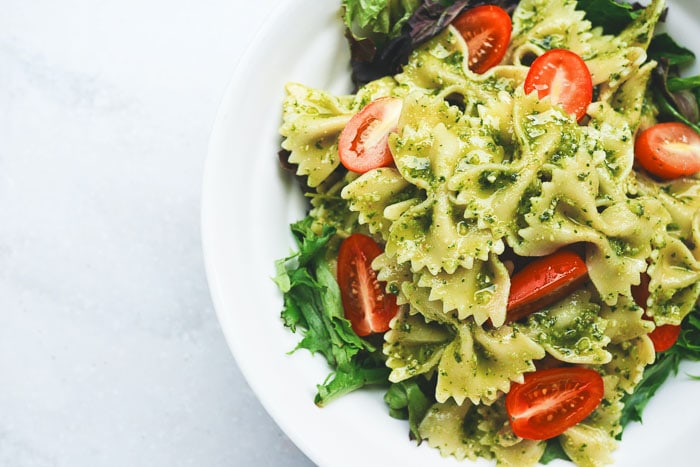
Is it necessary to reintroduce?
I sometimes get the question: “Is it really necessary to do the reintroduction phase? I feel so good now that I have done the elimination phase and I have my symptoms under control”.
“I don’t want to mess that up by doing the reintroduction”. I understand very well that you feel this way, it is so much more comfortable to stay in the safety of the elimination phase.
But there are a few reasons why it is highly recommended to move through the challenges:
- You will have more freedom: when you find out what your triggers are, you will have a lot more freedom in what to eat.
Most people find out that they can tolerate several FODMAP groups and being able to add those back into your diet gives you a lot more food freedom.
It will be easier to eat out, easier to enjoy meals at your friends and family’s houses. You will feel a lot less restricted and isolated. - It increases the variety of your diet: the low FODMAP diet is a very restrictive diet.
If you stay in the elimination phase, you might be unnecessarily restricting yourself and keeping important nutrients from your body. - FODMAP-rich foods are important for your gut bacteria: some foods that are high in FODMAPs help the growth of good bacteria in your gut. These bacteria act like probiotics.
Restricting FODMAP foods for too long can harm the variety of good gut bacteria in your gut, the health of your gut, and your overall health.
Therefore it is important to bring some high-FODMAP foods back into your diet.
Source: Monash FODMAP
How long does the reintroduction phase take?
Monash says the reintroduction phase is expected to take 6 to 8 weeks.
I personally find that quite short. They recommend 9 different tests, more about that below and I think for most people each test will take about a week.
If you don’t get symptoms you can move on to the next test quicker. Sometimes the tests can take a bit longer, for example when you go through a stressful period and experience increased symptoms.
In such periods, it is better to pause testing because you cannot be sure that the symptoms you have are because of the stress that you are in or because of the food that you tested.
How to do FODMAP reintroduction?
There are two ways to do the FODMAP reintroduction:
Three testing days in a row
- Day 1: test day – small amount
- Day 2: test day – moderate amount
- Day 3: test day – large amount
- Day 4-6: rest day
With this testing method, you do three testing days in a row. On the first day, you start with a small amount and you build this up to a large testing amount on day 3.
This is the testing method that Monash University advises because this will help you to move through the tests as quickly as possible. The advice is to always take 2-3 rest days after the 3 test days.
If you have symptoms, wait until your stomach is calm again before you proceed to the next test, also if this takes more than 3 days.
Source: Monash FODMAP
Three testing days with a rest day between each test
- Day 1: test day – small amount
- Day 2: rest day
- Day 3: test day – moderate amount
- Day 4: rest day
- Day 5: test day – large amount
- Day 6-8: rest day
With the second method, you do one testing day and then a rest day. Another testing day and a rest day again etc. This way of testing takes a little longer, but there are reasons why you would prefer to test with method two:
- If you have constipation it can take longer for your symptoms to show. So in that situation, it can be better to have a rest day between each test.
- If it makes you feel more secure to have a rest day between each test
- If your dietician recommends this schedule or another testing schedule that he or she thinks better fits
Which foods to use for the tests?
When picking testing foods it is important that these foods only contain one of the FODMAP groups.
Some foods contain a high amount of more than one FODMAP group and if you use one of those foods, you won’t know to which FODMAP group you react.
Therefore, pick foods that contain only one FODMAP. After you finish the reintroduction phase, you can start testing foods that contain more than one FODMAP.
Be aware that the recommendations for which foods to use for each test have changed over the years.
There are still lists around on the internet that are old and the foods that are recommended there might not always be the best foods for testing a group.
For example, because the food has quite a high low FODMAP serving size or because the food contains more than one FODMAP.
I recommend using the amounts stated in the Monash University FODMAP app. Because the app is always up-to-date and the app is made by the creators of the FODMAP diet.
You can find the recommended challenge foods by opening the app, clicking on the diary, clicking the plus on the upper right side, and then clicking the symbol with the apple and the arrow.
There you can select the FODMAP group and see which foods they recommend. Below I have listed a few options for each FODMAP group:
Fructose
Pick one of the foods below to test. Test the following amounts on days 1, 2, and 3:
- Honey: 1 1/2 tsp (10 g), 2 tsp (14 g), and 1 tbsp (28 g)
- Mango: 1/4 mango (52 g), 1/2 mango (104 g) and 1 mango (208 g)
- Orange juice: 2/3 cup (140 g), 3/4 cup (157 g), and 1 cup (201 g)
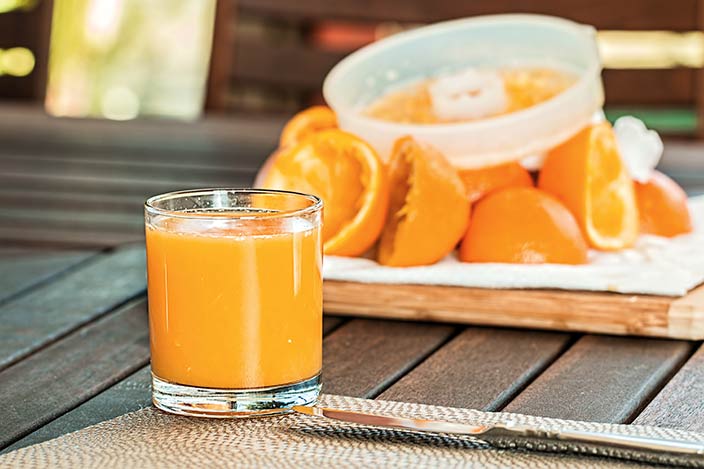
Lactose
Pick one of the foods below to test. Test the following amounts on days 1, 2, and 3:
- Yogurt: 1/2 tub (85 g), 1 tub (170 g), and 1 cup (200 g)
- Milk: 1/4 cup (60 ml), 1/2 cup (125 ml), and 1 cup (250 ml)
Mannitol
Pick one of the foods below to test. Test the following amounts on days 1, 2, and 3:
- Cauliflower: 2 small florets (17 g), 4 small florets (33 g), and 8 small florets (66 g)
- Sweet potato: 3/4 cup (105 g), 1 cup (140 g), and 1 1/2 cup (210 g)
Sorbitol
Pick one of the foods below to test. Test the following amounts on days 1, 2, and 3:
- Apricot: 1/2 apricot (28 grams), 1 apricot (56 grams), and 2 apricots (112 grams)
- Blackberries: 2-3 berries (13 g), 5 berries (25 g), and 10 berries (50 g)
- Peach: 1/4 peach (37 grams), 1/2 peach (73 grams), and 1 peach (146 grams)
Previously, avocado was also one of the test products for sorbitol. But Monash University retested avocado in 2024 and it turned out that avocado contains perseitol instead of sorbitol. Monash University now recommends testing avocados separately to see how you respond to perseitol.
Avocado cannot be used anymore as a test food for the group sorbitol.
Fructans – garlic
Garlic is tested separately in the fructans test. Test garlic in the following amounts on days 1, 2, and 3:
- Garlic: 1/4 clove, 1/2 clove, 1 whole clove
Fructans – onion
Onion is tested separately in the fructans test. Test one of these options on days 1, 2, and 3:
- Onion (red or white): 1/8 onion (11 g), 1/4 onion (22 g), and 1/2 onion (44 g)
Fructans – grain
Grains are tested separately in the fructans test. Test one of these options on days 1, 2, and 3:
- Wholegrain wheat bread: 1 slice (26 g), 1 1/2 slices (39 g), and 2 slices (52 g)
- Wheat pasta: 2/3 cup (100 g), 1 cup (150 g), 1 1/2 cup (220 g)(cooked weight)
Fructans – vegetable and fruits
Monash also recommends testing a fructan vegetable or fruit. Test one of these options on days 1, 2, and 3:
- Raisins: 1 1/2 tbsp (19 g), 2 tbsp (26 g), and 3 tbsp (39 g)
- Grapefruit: 1/2 medium (104 g), 1 medium (207 g), and 1 large (280 g)
- Brussels sprouts: 3 sprouts (57 g), 4 sprouts (76 g), and 5 sprouts (95 g)
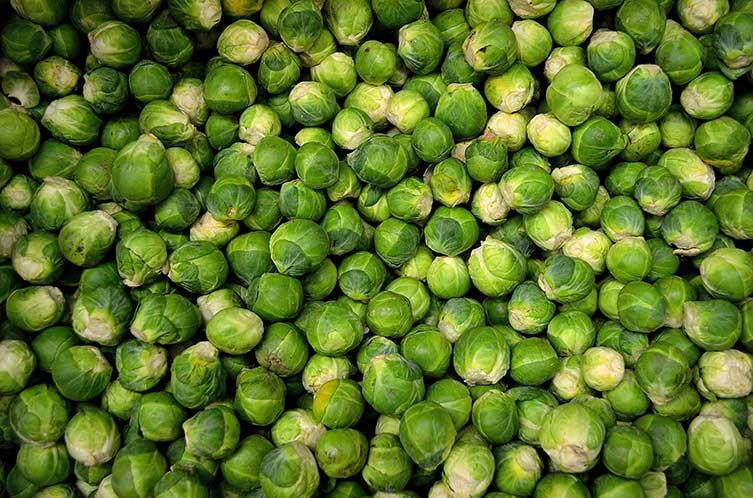
Galactans (GOS)
Pick one of the foods below to test. Test the following amounts on days 1, 2, and 3:
- Almonds: 15 nuts, 20 nuts, and 30 nuts
- Canned chickpeas, rinsed: 1/2 cup (84 g), 2/3 cup (112 g), and 1 cup (168 g)
Which group should I test first?
It doesn’t matter which group you test first. Most people start with the group that they are most curious about because they want to know if they can or cannot add that group back into their diet.
But there is no fixed order that you have to follow.
How to make your reintroduction a success
Some tips that can help you move through the reintroduction phase smoothly:
- Make sure that you continue to eat strictly low FODMAP through the entire reintroduction phase. If you don’t do this, you can get symptoms and this might interfere with your test results.
- Don’t add the FODMAP groups that you didn’t react to back into your diet until you have finished the reintroduction phase.
- Keep a food- and symptom diary to track how you are reacting to the different tests and to know when you are ready for the next one.
- Do the reintroduction phase under the guidance of a FODMAP-certified dietician, so you have somebody to help you interpret test results and symptoms.
- Wait until your symptoms have settled before you start a new test.
Frequently asked questions about the FODMAP reintroduction phase
There are several questions that I often get asked about the reintroduction phase.
I have bundled all of those questions and in this blog, FODMAP-certified dietician Manon te Linde answers all frequently asked questions about the reintroduction phase.
So head over to that blog to get your questions answered.
Some more helpful content
Looking for more information and tips for the low FODMAP diet? Also, check out these articles:
- 80+ low FODMAP snacks
- 100 tips for the FODMAP diet: everything you need to know
- The elimination phase
I hope this blog has helped you to navigate the reintroduction phase. Do you have more questions? Feel free to ask them below or to ask them in the Karlijn’s Kitchen Facebook community. A closed Facebook group where you can ask questions and share your experiences with other fodmappers.

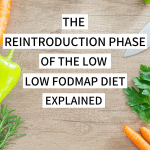
42 Comments
Thanks for this info! I’m struggling to add bread as I feel this gives me a flare-up, But don’t many people say the same thing if they haven’t had bread for a long time?
The way you present information is really easy to follow. I’m about a week away from starting the tests, so I’m looking at a bunch of advice and yours is the clearest. Thank you!
I am happy to hear that, Andrew. You are welcome 🙂
I am testing bread today and so far I am not suffering any pain but I am a little bloated. I am nervous about testing the garlic and onions, but will try in very small amounts first. Will post my results.
Two weeks left of testing. Reaction to fructan and lactose with severe reactions to fructose (does it make anyone else itchy?). Just onions and GOS to go. Takes a long time, but worth it.
I am starting to reintroduce garlic and onion to test them. I am nervous about it because I have been feeling better than I have in years. I have successfully tested the fruit and the bread. I found that I really like the taste of Gluten free pasta even if I can tolerate regular pasta. I will post the results later.
Hi there, have you found that most people respond the same to onion and garlic? I did garlic reintroduction but had enough by day two. I really don’t want to go through the same again with onion. Also I do fine with sourdough AP flour bread and some spelt, so I don’t have a desire to specifically test wheat. I’m very sad that I did not pass the apple test. It’s one of the foods I miss the most.
I have heard different reactions. Monash states them as two separate groups to test, so therefore it would be best to test them both, just to be sure. It is possible that you reacted to garlic, but that you won’t react to onion.
I reintroduced onions in a small amount and had a severe reaction. Three days of constant diarrea. I will wait awhile before trying anything else.
Does onion and/or garlic need to be raw or can it be cooked/fried? Does it make a difference?
I always advise to prepare the test foods how you would normally eat them. So if you would most often eat raw onion, also test it raw. If you always fry/cook it, then also cook it now.
Thank you for putting together this article! It has been super helpful. I was wondering are the measurements for raw garlic and onion or cooked?
I weighed the raw ingredients and had them cooked. If I didn’t react to the largest amount in the reintroduction phase is it safe to say I may be ok with larger amounts of garlic/onion? A lot of dishes I used to eat had a lot of garlic (5+) and onion.
Also, do you (or anyone) recommend which brand of bread to test? I’m having the hardest time figuring out which one to buy. What should be the main ingredient? Most of them have tons of ingredients. Thank you!
I am not sure to be honest, Monash doesn’t say whether they mean raw or cooked onion and garlic. I would assume raw.
I would do the same as you did: measure them raw, eat them cooked.
I would always test how you react to larger amounts first. The only thing you know for sure now is that you don’t react to the largest amount you tested. So your tolerance for garlic / onion is probably quite high. But if you want to add a lot more garlic and onion to your meals I would test how you react to that as well.
For bread, it is hard to give you advice because I am in the Netherlands and we have very different brands here. I would suggest to test with a bread that you would like to continue eating after the reintroduction phase. So bread that you used to eat before you started the FODMAP diet.
Thanks for asking that question I was wondering that as well.
Thank you for the clear presentation of the reintroduction phase. Well done. Easy to understand!
Happy to hear that! You’re welcome 🙂
Thank you so much for sharing, this article has help me to understand the next step before speaking with my dietitian next week.
Thankyou for your information and peoples comments. I will be reintroducing after Xmas. I feel more hopeful now!
Good luck!
Thanks, this is a fantastic roadmap for the reintroduction phase! I’m really grateful that you took the trouble to post it, and have replied to most people in the comments! I’ll be back for more info and guidance!! ???
You’re welcome 🙂 I am happy you find it useful!
Do have to use white or red onions. Isyellow ok
I think any of those are fine
Thanks for all the clear information. I want to make sure I understand; when you reintroduce like for lactose – we should do the yogurt AND milk or one or the other?
For lactose testing one food is sufficient, so yoghurt OR milk is ok
I am allergic to a variety of berries and HATE avocado. Is there a recommendation on what else I can try for sorbitol?
The Monash app also gives apricot and peach as options for testing sorbitol. Maybe that’s an option?
I think I am only going to test hard cheeses, as I do not normally consume milk and yogurt from dairy. I know I am lactose intolerant, so that is all I eat for dairy products. I will not test fructans from wheat since I am gluten-free. But I am only going on week 2 of elimination right now, so I have 5 more weeks to go. Today is the last day of week 1.
Hi there! I’m starting the reintroduction phase right now and am almost done with testing lactose. Assuming I have no issues with lactose, when I move on to test other groups, is it okay to consume foods with lactose at the same time? Or must we avoid all other high FODMAP foods even if they are considered safe for us after reintroducing it when testing a new group? Thank you!
Usually it is advised to wait with adding groups back into your diet until you have finished the reintroduction phase.
I am about to enter the Challenge Stage, very excited for this. Can I add meat or spices or red sauce or salad instead of the garlic or onion
I don’t fully understand your question, I am sorry. Could you explain a bit more what you mean?
Thank you so much for this posting. It helped me set up my reintroduction phase schedule. Your choices helped me schedule the foods to use when testing.
So far, only reacted to Lactose on day two with bloating and to onions on day two with flatus/gas. Will retest both when I finish other categories. Only have Sorbitol, Mannitol, GOS, and Fructose left to try.
With your guidance and suggestions, this is not complicated at all.
FYI-when airplane traveling, I packed Low Fodmap foods and empty freezer storage bags then after going through TSA, obtained ice cubes from a merchant, place them in the plastic bags and my foods stayed cool and fresh. I got the idea off another blog and this really worked well.
GREAT and supportive LowFodmap following out there.
Hi Mary, I am happy to hear that this helped you! Thank you for your tips on low FODMAP travelling 🙂
So so easy to follow, I have introduced chilli, cauliflower so far, both were not great! Chilli caused stomach pains, cauliflower excessive gas! Will try onions and garlic in a few days time, enjoying the calm beforehand. Thanks so much for your expert advice. X
So happy to find this information. Practical options with actual amounts to try each day, clear conscise, immeasureably helpful. I look forward to the challenges. Thank you so much!
You’re welcome!
Hello,
For the serving sizes in the reintroduction phase, is this to be spread out throughout the day or during one meal? For example, having 1/8 of an onion on Day 1 could be done with one meal. However, 1/2 of an onion on Day 3 seems like too much to eat in one meal.
I think it is best to test it in one meal. But if you would never eat that amount in a meal, you can also skip the third testing amount.
Thank you!!
Hello,
I stumbled across your site looking for low FODMAP vegan recipes because I know I don’t tolerate fructans. I was interested in getting the Montash app but was wondering if it would just have a lot of food brands popular in the Netherlands but few brands from the US where I live. I’m on the fence about the app but know the basic unprocessed fruits, vegetables and grains would be the same. Also, is there a filter to adjust serving sizes to volume (eg—cups) vs weight (grams). I don’t know how you all deal with weighing everything. 😉. Thanks!
Hi Becky, the Monash app is actually Australian and is more focused on Australian foods and US foods than foods from the Netherlands. Its serving sizes are both volume and weigh based.So I think it will be useful to you 🙂